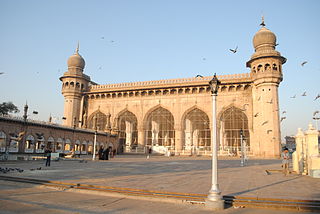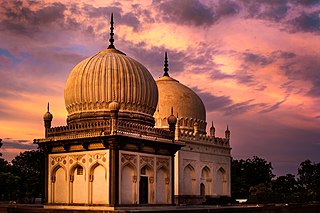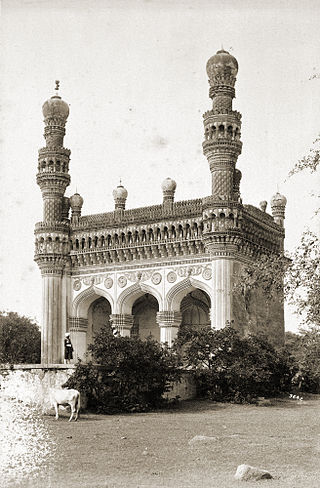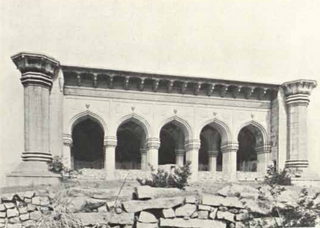| Masjid Uppal Kalan | |
|---|---|
 | |
| Religion | |
| Affiliation | Islam |
| Location | |
| Location | Hyderabad |
Masjid Uppal Kalan is a mosque in the Uppal Kalan neighborhood of Hyderabad. [1]
| Masjid Uppal Kalan | |
|---|---|
 | |
| Religion | |
| Affiliation | Islam |
| Location | |
| Location | Hyderabad |
Masjid Uppal Kalan is a mosque in the Uppal Kalan neighborhood of Hyderabad. [1]
It was built in the 1660s by Abdullah Qutb Shah.
It is built on a plinth, which is accessed by a flight of stairs. The facade has three arched entrances, over which is a chajja supported by stone brackets. The facade is flanked by two tall minarets on either side, with two smaller minarets at the rear of the mosque. [2]
The Qutb Minar, also spelled Qutub Minar and Qutab Minar, is a minaret and victory tower comprising the Qutb complex, which lies at the site of Delhi's oldest fortified city, Lal Kot, founded by the Tomar Rajputs. It is a UNESCO World Heritage Site in the Mehrauli area of South Delhi, India. It was mostly built between 1199 and 1220, contains 399 steps, and is one of the most-frequented heritage spots in the city. Qutab-ud-din Aibak initiated construction of the Qutub Minar, but only managed to finish the first level. Successors continued the construction, and, in 1368, Firuz Shah Tughlaq rebuilt the top parts and added a cupola.

The Charminar is a monument located in Hyderabad, Telangana, India. Constructed in 1591, the landmark is a symbol of Hyderabad and officially incorporated in the emblem of Telangana. The Charminar's long history includes the existence of a mosque on its top floor for more than 425 years. While both historically and religiously significant, it is also known for its popular and busy local markets surrounding the structure, and has become one of the most frequented tourist attractions in Hyderabad. Charminar is also a site of numerous festival celebrations, such as Eid-ul-adha and Eid al-Fitr, as it is adjacent to the city's main mosque, the Makkah Masjid.

Makkah Masjid or Mecca Masjid, is a congregational mosque in Hyderabad, India. It is the largest mosque in the city, and one of the largest in the country, with a capacity of 10,000 people. The mosque was built during the 17th century, and is a state-protected monument. It serves as the primary mosque for the Old City of Hyderabad, and is located close to the historic landmarks of Charminar, Chowmahalla Palace and Laad Bazaar.

Indo-Islamic architecture is the architecture of the Indian subcontinent produced by and for Islamic patrons and purposes. Despite an initial Arab presence in Sindh, the development of Indo-Islamic architecture began in earnest with the establishment of Delhi as the capital of the Ghurid dynasty in 1193. Succeeding the Ghurids was the Delhi Sultanate, a series of Central Asian dynasties that consolidated much of North, East, and Central India, and later by the Mughal Empire during the early 16th century. Both of these dynasties introduced Islamic architecture and art styles from West Asia into the Indian subcontinent.

Po-i-Kalan, or Poi Kalan, is an Islamic religious complex located in Bukhara, Uzbekistan. The complex consists of three parts, the Kalan Mosque, the Kalan Minaret to which the name refers, and the Mir-i-Arab Madrasah. The positioning of the three structures creates a square courtyard in its center, with the Mir-i-Arab and the Kalan Mosque standing on opposite ends. In addition, the square is enclosed by a bazaar and a set of baths connected to the Minaret on the northern and southern ends respectively.

Uppal is a neighbourhood in Eastern Hyderabad, Telangana, India. It is the mandal headquarters of Uppal mandal in Keesara revenue division in Medchal-Malkajgiri district. It forms Circle No.2 in the L. B. Nagar Zone of Greater Hyderabad Municipal Corporation. There are four wards i.e., Chilukanagar (7), Habsiguda (8), Ramanthapur (9) and Uppal (10) in this circle.

The Qutub Shahi Tombs are located in the Ibrahim Bagh, close to the famous Golconda Fort in Hyderabad, India. They contain the tombs and mosques built by the various kings of the Qutub Shahi dynasty. The galleries of the smaller tombs are of a single storey while the larger ones are two-storied. In the centre of each tomb is a sarcophagus which overlies the actual burial vault in a crypt below. The domes were originally overlaid with blue and green tiles, of which only a few pieces now remain.

The Old City of Hyderabad is a walled city of Hyderabad, Telangana, India, located on the banks of the Musi River built by Qutb Shahi sultan Muhammed Quli Qutb Shah in 1591 AD. There used to be a wall surrounding the Old City, most of which is destroyed. Mubariz Khan, the Mughal governor of Deccan Subah, had fortified the city in 1712 and was completed by Nizam of Hyderabad.

Khairatabad Mosque is in Khairatabad. Today Khairatabad is a well-known locality built around the mosque. The area had become a major business and IT hub of Hyderabad, India.

Hayat Bakshi Mosque also Hayat Bakshi Begum Masjid is a mosque located in Hayathnagar, near Hyderabad, India. It was constructed in 1672 during the reign of Abdullah Qutb Shah the fifth Sultan of Golconda, and named after Hayat Bakshi Begum.

Toli Masjid, also known as Damri Masjid, is a mosque in Hyderabad, in the Indian state of Telangana. It was constructed during the Qutb Shahi period and completed in 1671.
The Telangana Tourism Development Corporation is a state government agency which promotes tourism in Telangana, a state in the Southern region of India. The retired Director General of Police Pervaram Ramulu is the appointed First chairman of Telangana State Tourism. Tourist attractions in Telangana include historical places, monuments, forts, waterfalls, forests and temples.

Qutb al-Din Shah Masjid, not to be confused with Masjid Qutbuddin Ahmad Shah (1414), is a medieval mosque built in 1449 in Ahmedabad district, Gujarat, India. Although the mosque is not considered a distinctive building by scholars, it exemplifies the progression of the Indo-Islamic architectural style of Ahmedabad in the 15th century.

The Musheerabad Masjid or Masjid e Kalan, is a mosque located in the Musheerabad locality of Hyderabad, India. The original portion was constructed in 1560 AD by Ibrahim Quli Qutb Shah, the fourth Sultan of the Qutb Shahi dynasty and is identical to the Hayat Bakshi Mosque located in Hayathnagar area of Hyderabad.

Kulsum Begum Masjid is a mosque in the Karwan locality of Hyderabad, India. It was built in the 17th century by Kulsum Begum, daughter of Sultan Muhammad Qutb Shah.

The architecture of Telangana dates back over two thousand years. The Indian state of Telangana is in the Deccan plateau, bordering the coastal plain of Andhra Pradesh. It has produced regional variants of wider styles of Indian architecture, both in Hindu temple architecture and Indo-Islamic architecture.

A distinct Indo-Islamic architecture style with local contribution is reflected in the historical buildings of Hyderabad, making it the first and "Best Heritage City of India" as of March 2012. The city houses many famous historical sites constructed during Qutb Shahi and Asaf Jahi period, including various mosques and palaces.
Qutb Shahi architecture is the distinct style of Indo-Islamic architecture developed during the reign of the Qutb Shahi dynasty, also known as the Golconda Sultanate.

The Afzal Gunj Masjid, also known as AfzalGunj Masjid or Afzalgunj Mosque, is a mosque located in the Afzalgunj, Hyderabad, India. The mosque was constructed in 1866 by Afzal-ud-Daulah, the fifth Nizam of Hyderabad, after the construction of Nayapul which connects the city with its new establishment. The mosque is constructed in a style of three arched facade and the two minarets in the front corner of rectangular hall.

The Premamati Mosque is a mosque in Hyderabad, India.